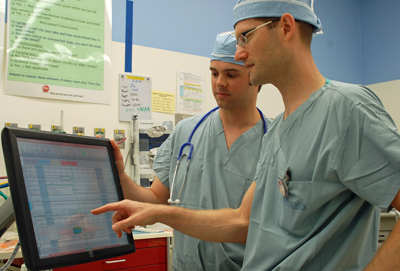Perioperative Information Management System Launched

Anesthesiologists Erik Anderson, MD, and Todd Telle, MD, review information through the Perioperative Information Management System.
Thanks to the Perioperative Information Management System (PIMS), anesthesiologists will no longer need to take time away from patient care during a surgical case to write down a patient’s blood pressure, heart rate and medications to later incorporate into a paper medical record. Instead, the PIMS software will automatically feed the patient’s vital signs and other critical case information into the new electronic medical record (EMR), resulting in a more accurate and always accessible anesthetic record.
“I can focus on the patient while the system documents for me,” said anesthesiologist Erik Anderson, MD, who is among the first super users of PIMS.
PIMS anesthesia is used in the general, ambulatory, orthopedic and cardiac surgery Operating Rooms on a rotating basis. A print-out of the electronic record is placed in the patient’s chart when the patient arrives in the recovery area. Once it is rolled out to all the ORs, this new system will provide completely legible intra-operative records to all care providers, the ability to access prior intra-operative anesthetic records to prepare for future surgeries and the opportunity to collect data to improve perioperative patient care quality.
“The ultimate goal is to allow providers to access and contribute to perioperative patient records electronically from any location in the hospital at any time, including all anesthetizing locations, the preoperative clinic, pre-op holding, PACU, inpatient floors, surgical ICUs and Labor & Delivery,” said Andy Mawson, PIMS IS project manager.
“From a Biomedical Engineering perspective, PIMS highlights how the integration and connectivity of multiple medical devices can be made into a system, which permits patient data and patient information to be increasingly accessible to clinicians and assists with patients’ care,” said Trevor Roberts, PIMS clinical engineer.
The development of PIMS is due to a successful collaboration between several departments. Biomedical Engineering integrated patient monitor data into PIMS and provides first line support to end-users. Anesthesiology, Perioperative and Pain Medicine provided clinical content expertise to customize the vendor iMDsoft’s product to match BWH workflow. Partners Information Systems integrated the software with hospital information systems and manages the project, providing application support during go-live. Perioperative Nursing and Nursing Services have provided support for the project in the Postoperative Anesthesia Care Unit, Day Surgery Unit recovery area and intensive care units.
“We are all very excited by the introduction of an EMR to the BWH ORs and are very appreciative of the collaboration of the multi-disciplinary group that helped make this a reality,” said Pankaj Sarin, MD, MS, PIMS clinical lead. “We look forward to the next steps of the project, which will enable BWH to continue to improve its high quality patient care through an effective use of information technology.”